Moderate Inflation and Disinflation
The governments of wealthy, politically stable countries, like the United States and Britain, don’t find themselves forced to print money to pay their bills. Yet over the past 40 years, both countries, along with a number of other nations, have experienced uncomfortable episodes of inflation. In the United States, the inflation rate peaked at 13% at the beginning of the 1980s. In Britain, the inflation rate reached 26% in 1975. Why did policy makers allow this to happen?
The answer, in brief, is that in the short run, policies that produce a booming economy also tend to lead to higher inflation, and policies that reduce inflation tend to depress the economy. This creates both temptations and dilemmas for governments.
First, imagine yourself as a politician facing an election in a year or two, and suppose that inflation is fairly low at the moment. You might well be tempted to pursue expansionary policies that will push the unemployment rate down as a way to please voters, even if your economic advisers warn that this will eventually lead to higher inflation. You might also be tempted to find different economic advisers who will tell you not to worry: in politics, as in ordinary life, wishful thinking often prevails over realistic analysis.
Conversely, imagine yourself as a politician in an economy suffering from inflation. Your economic advisers will probably tell you that the only way to bring inflation down is to push the economy into a recession, which will lead to temporarily higher unemployment. Are you willing to pay that price? Maybe not.
This political asymmetry—
But why do expansionary policies lead to inflation? To answer that question, we need to look first at the relationship between output and unemployment.
The Output Gap and the Unemployment Rate
In Chapter 12 we introduced the concept of potential output, the level of real GDP that the economy would produce once all prices had fully adjusted. Potential output typically grows steadily over time, reflecting long-
Recall from Chapter 12 that the percentage difference between the actual level of real GDP and potential output is called the output gap. A positive or negative output gap occurs when an economy is producing more than or less than what would be “expected” because all prices have not yet adjusted. And wages, as we’ve learned, are the prices in the labor market.
Meanwhile, we learned in Chapter 8 that the unemployment rate is composed of cyclical unemployment and natural unemployment, the portion of the unemployment rate unaffected by the business cycle. So there is a relationship between the unemployment rate and the output gap. This relationship is defined by two rules:
When actual aggregate output is equal to potential output, the actual unemployment rate is equal to the natural rate of unemployment.
When the output gap is positive (an inflationary gap), the unemployment rate is below the natural rate. When the output gap is negative (a recessionary gap), the unemployment rate is above the natural rate.
In other words, fluctuations of aggregate output around the long-
This makes sense. When the economy is producing less than potential output—
Figure 16-4 confirms this rule. Panel (a) shows the actual and natural rates of unemployment, as estimated by the Congressional Budget Office (CBO). Panel (b) shows two series. One is cyclical unemployment: the difference between the actual unemployment rate and the CBO estimate of the natural rate of unemployment, measured on the left. The other is the CBO estimate of the output gap, measured on the right. To make the relationship clearer, the output gap series is inverted—
16-4
Cyclical Unemployment and the Output Gap
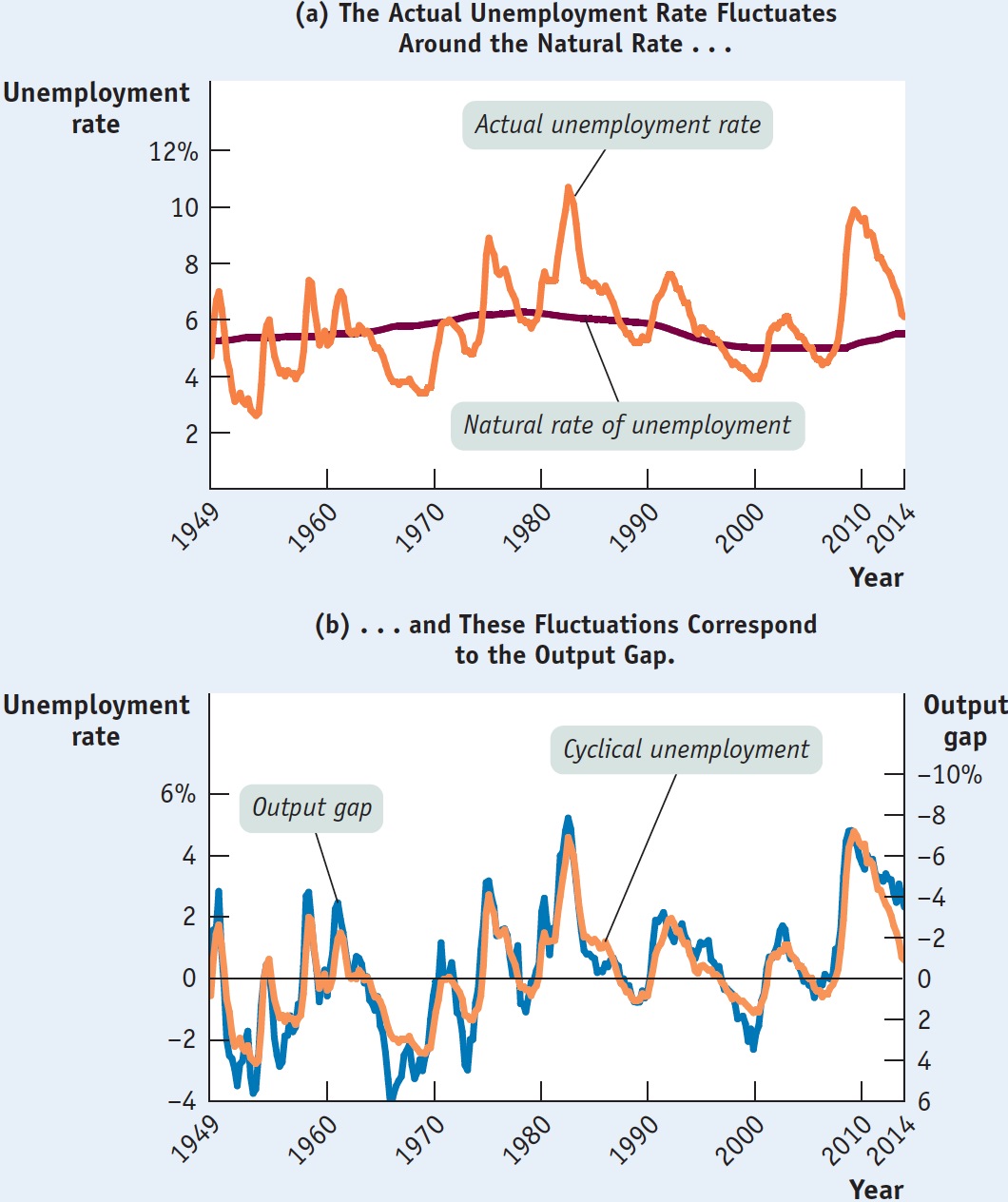
As you can see, the two series move together quite closely, showing the strong relationship between the output gap and cyclical unemployment. Years of high cyclical unemployment, like 1982, 1992, or 2009, were also years of a strongly negative output gap. Years of low cyclical unemployment, like the late 1960s or 2000, were also years of a strongly positive output gap.
Okun’s Law
Although cyclical unemployment and the output gap move together, cyclical unemployment seems to move less than the output gap. For example, the output gap reached −8% in 1982, but the cyclical unemployment rate reached only 4%. This observation is the basis of an important relationship originally discovered by Arthur Okun, John F. Kennedy’s chief economic adviser.
Okun’s law is the negative relationship between the output gap and cyclical unemployment.
Modern estimates of Okun’s law—the negative relationship between the output gap and the unemployment rate—
For example, suppose that the natural rate of unemployment is 5.2% and that the economy is currently producing at only 98% of potential output. In that case, the output gap is −2%, and Okun’s law predicts an unemployment rate of 5.2% − ½ × (–2%) = 6.2%.
The fact that a 1% rise in output reduces the unemployment rate by only ½ of 1% may seem puzzling: you might have expected to see a one-
The answer is no: there are several well-
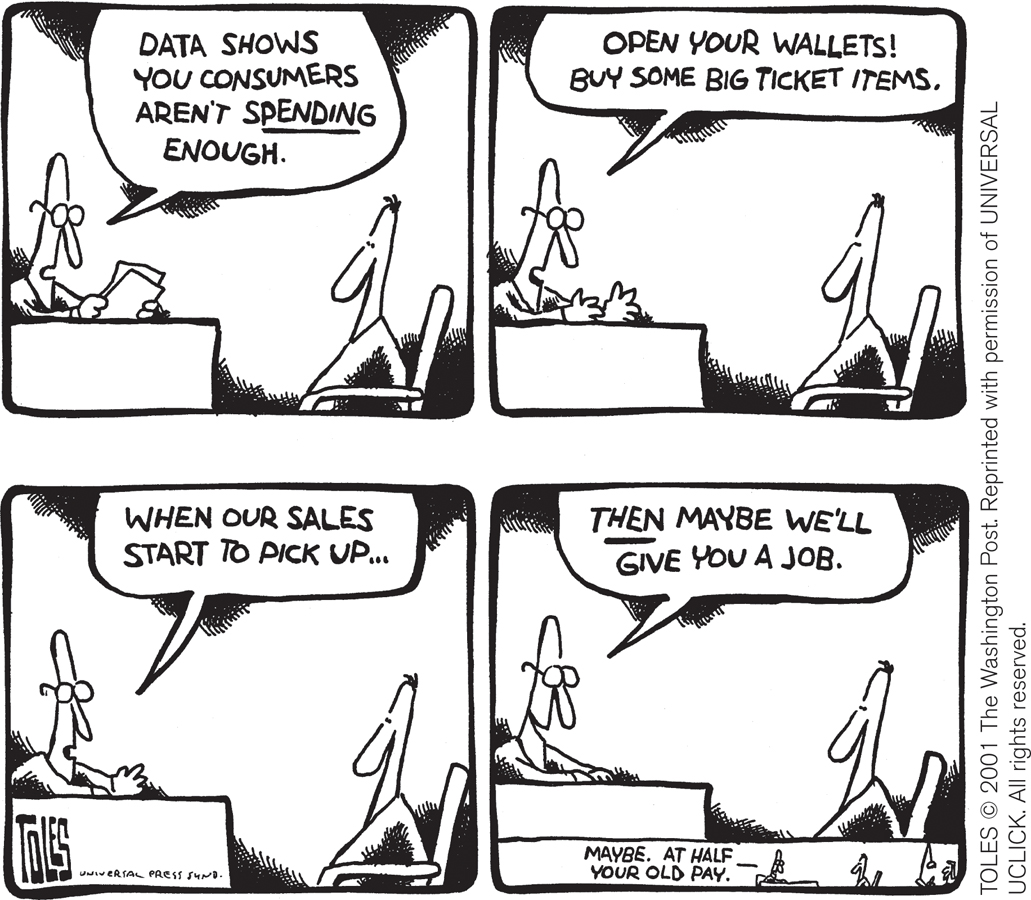
Also, the number of workers looking for jobs is affected by the availability of jobs. Suppose that the number of jobs falls by 1 million. Measured unemployment will rise by less than 1 million because some unemployed workers become discouraged and give up actively looking for work. (Recall from Chapter 8 that workers aren’t counted as unemployed unless they are actively seeking work.) Conversely, if the economy adds 1 million jobs, some people who haven’t been actively looking for work will begin doing so. As a result, measured unemployment will fall by less than 1 million.
Finally, the rate of growth of labor productivity generally accelerates during booms and slows down or even turns negative during busts. The reasons for this phenomenon are the subject of some dispute among economists. The consequence, however, is that the effects of booms and busts on the unemployment rate are dampened.
The Short-Run Phillips Curve
We’ve just seen that expansionary policies lead to a lower unemployment rate. Our next step in understanding the temptations and dilemmas facing governments is to show that there is a short-
The origins of this concept lie in a famous 1958 paper by the New Zealand–
16-5
Unemployment and Inflation, 1955–
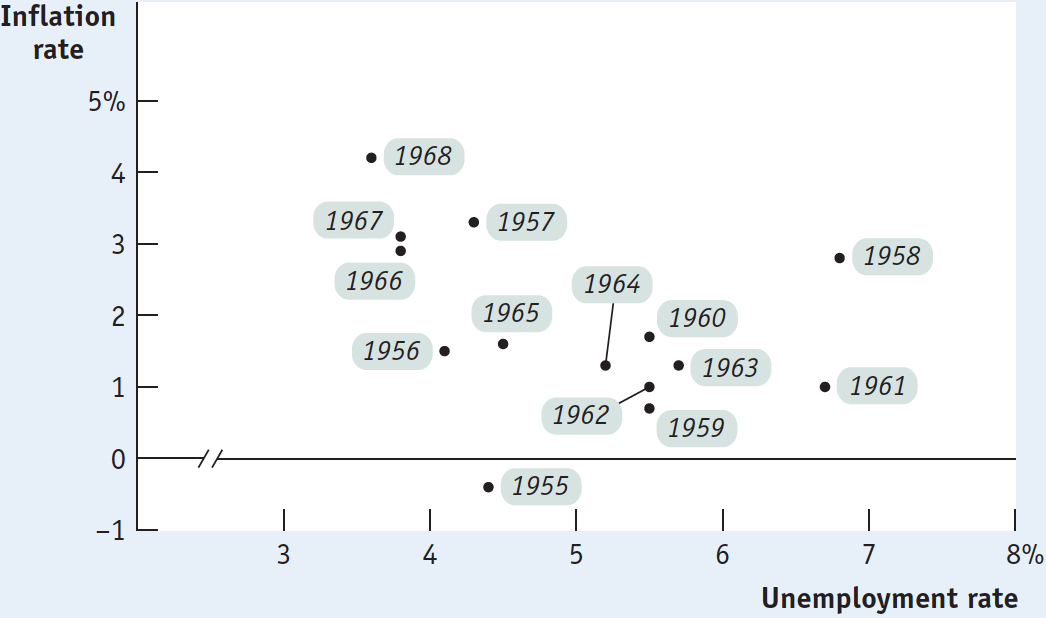
Looking at evidence like Figure 16-5, many economists concluded that there is a negative short-
16-6
The Short-
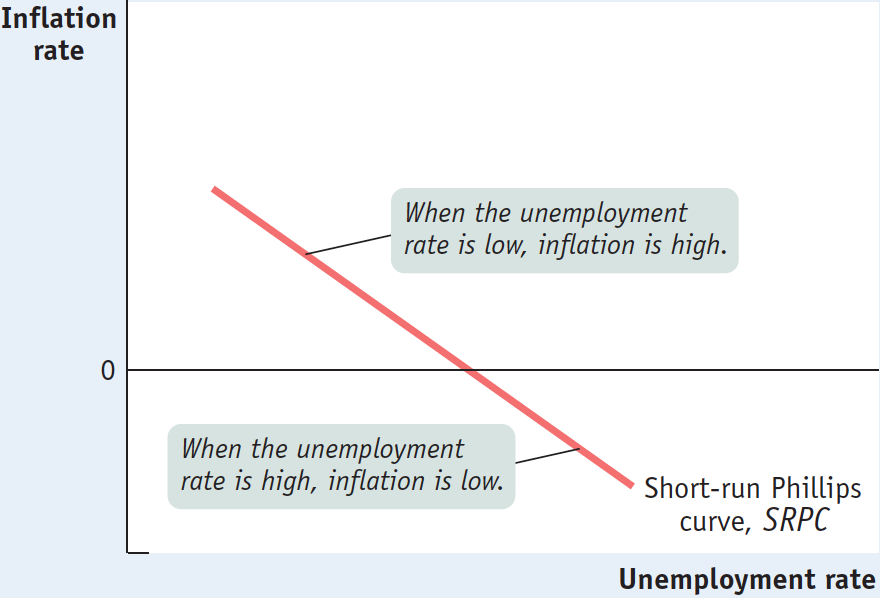
The short-
Early estimates of the short-
Even at the time, however, some economists argued that a more accurate short-
The Aggregate Supply Curve and the Short-Run Phillips Curve
In earlier chapters we made extensive use of the AD–
We can get a partial answer to this question by looking at panel (a) of Figure 16-7, which shows how changes in the aggregate price level and the output gap depend on changes in aggregate demand. Assume that in year 1 the aggregate demand curve is AD1, the long-
16-7
The AD–
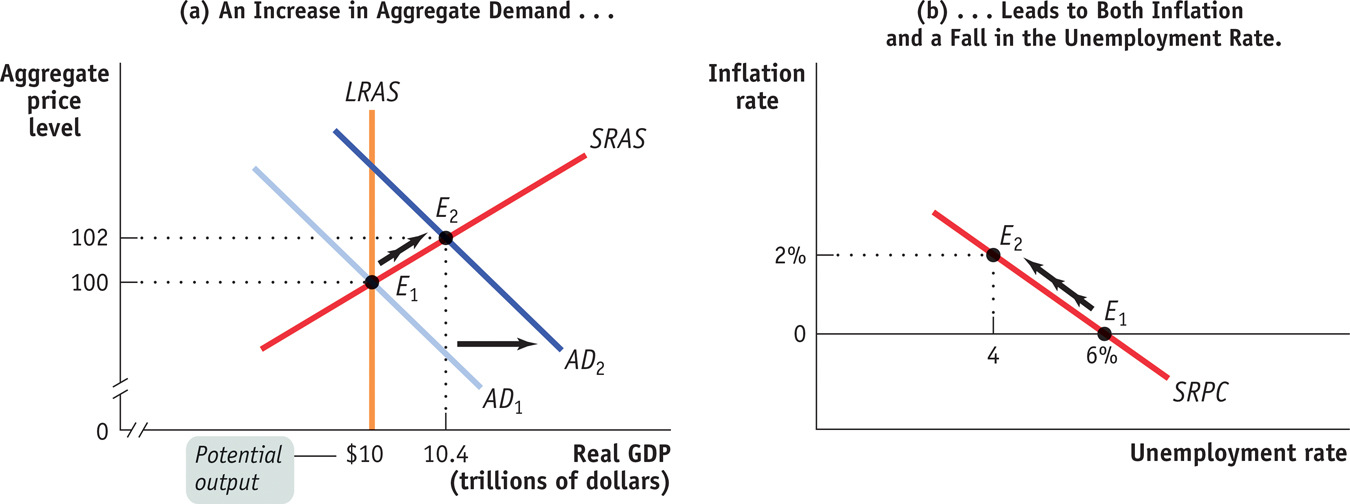
Now consider two possible paths for the economy over the next year. One is that aggregate demand remains unchanged and the economy stays at E1. The other is that aggregate demand shifts rightward to AD2 and the economy moves to E2.
At E2, real GDP is $10.4 trillion, $0.4 trillion more than potential output—
Panel (b) shows what this implies for the relationship between unemployment and inflation. Assume that the natural rate of unemployment is 6% and that a rise of 1 percentage point in the output gap causes a fall of ½ percentage point in the unemployment rate per Okun’s law, described in the previous For Inquiring Minds. In that case, the two cases shown in panel (a)—aggregate demand either staying put or rising—
So does the short-
16-8
The Short-
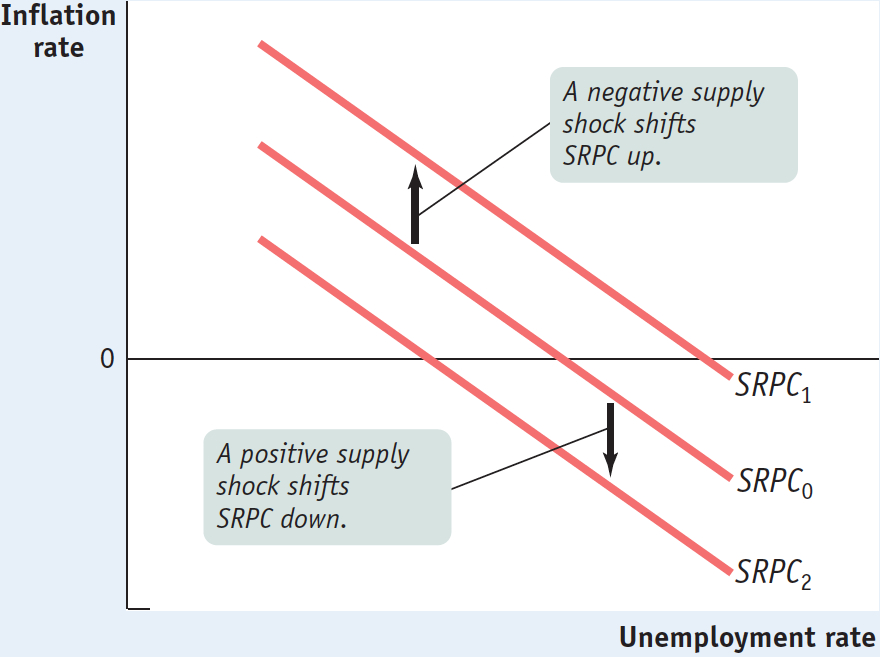
But supply shocks are not the only factors that can change the inflation rate. In the early 1960s, Americans had little experience with inflation because inflation rates had been low for decades. But by the late 1960s, after inflation had been steadily increasing for a number of years, Americans had come to expect future inflation. In 1968, two economists—
Inflation Expectations and the Short-Run Phillips Curve
The expected rate of inflation is the rate of inflation that employers and workers expect in the near future. One of the crucial discoveries of modern macroeconomics is that changes in the expected rate of inflation affect the short-
Why do changes in expected inflation affect the short-
For these reasons, an increase in expected inflation shifts the short-
Figure 16-9 shows how the expected rate of inflation affects the short-
16-9
Expected Inflation and the Short-
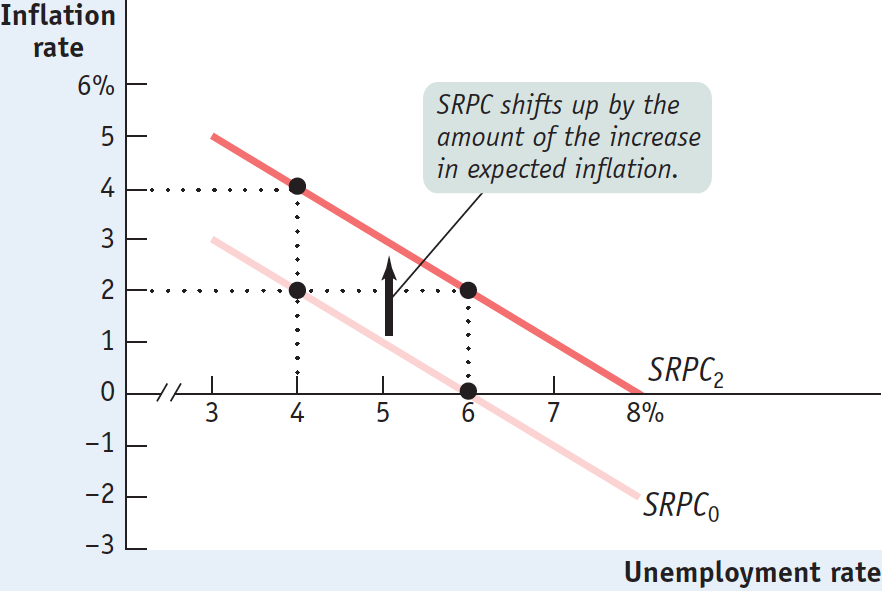
Alternatively, suppose the expected rate of inflation is 2%. In that case, employers and workers will build this expectation into wages and prices: at any given unemployment rate, the actual inflation rate will be 2 percentage points higher than it would be if people expected 0% inflation. SRPC2, which shows the Phillips curve when the expected inflation rate is 2%, is SRPC0 shifted upward by 2 percentage points at every level of unemployment. According to SRPC2, the actual inflation rate will be 2% if the unemployment rate is 6%; it will be 4% if the unemployment rate is 4%.
What determines the expected rate of inflation? In general, people base their expectations about inflation on experience. If the inflation rate has hovered around 0% in the last few years, people will expect it to be around 0% in the near future. But if the inflation rate has averaged around 5% lately, people will expect inflation to be around 5% in the near future.
Since expected inflation is an important part of the modern discussion about the short-
Sure enough, the seemingly clear relationship between inflation and unemployment fell apart after 1969. Figure 16-10 plots the track of U.S. unemployment and inflation rates from 1961 to 1990. As you can see, the track looks more like a tangled piece of yarn than like a smooth curve.
16-10
Unemployment and Inflation, 1961–
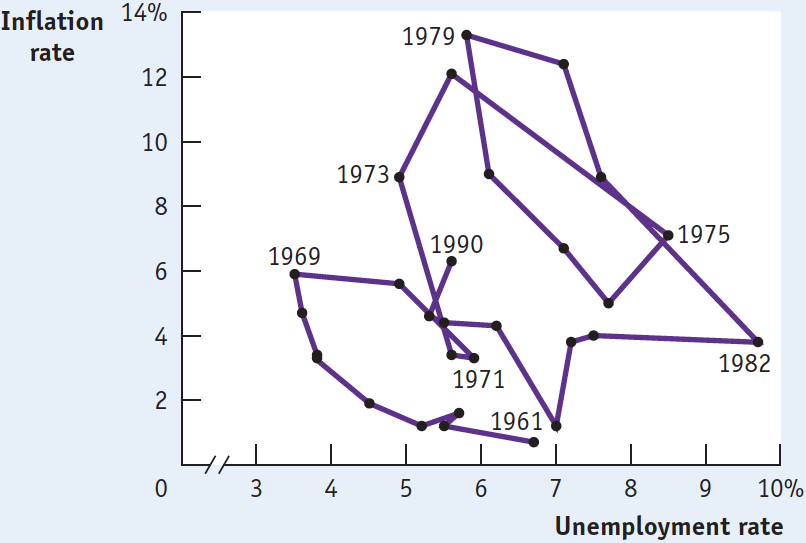
Through much of the 1970s and early 1980s, the economy suffered from a combination of above-
Part of the answer can be attributed to a series of negative supply shocks that the U.S. economy suffered during the 1970s. The price of oil, in particular, soared as wars and revolutions in the Middle East led to a reduction in oil supplies and as oil-
Equally important, however, was the role of expected inflation. As mentioned earlier in the chapter, inflation accelerated during the 1960s. During the 1970s, the public came to expect high inflation, and this also shifted the short-
!worldview! ECONOMICS in Action: The Phillips Curve in the Great Recession
The Phillips Curve in the Great Recession
We have returned many times in the course of this book to the great global economic crisis that struck in 2008. This crisis caused a drastic rise in unemployment in many countries, especially in some (but not all) European nations, and unemployment remained high even years later. According to the logic of the Phillips curve, this surge in unemployment should have led to falling inflation, with the biggest declines in the worst-
16-11
Rising Unemployment, Falling Inflation in Europe, 2007–
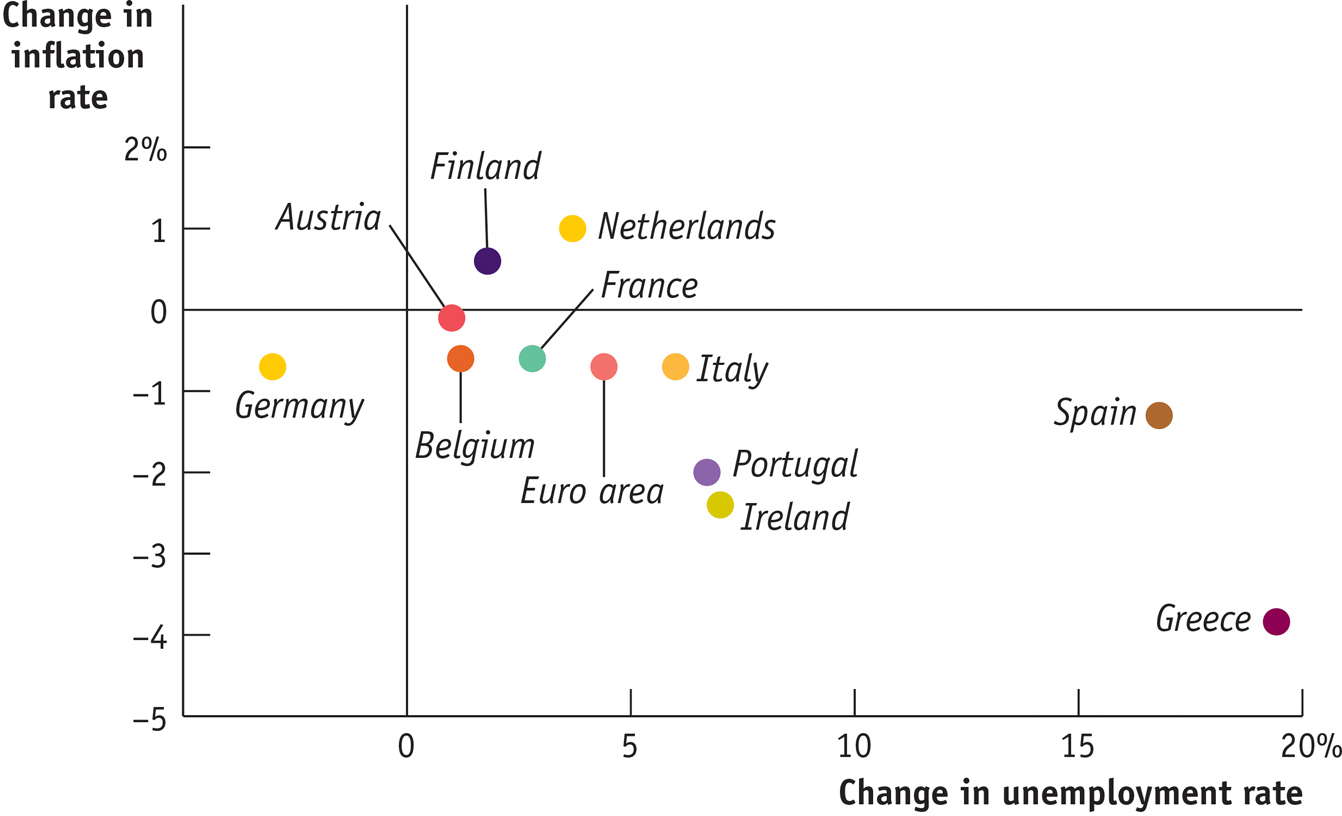
Figure 16-11 shows how unemployment rates and inflation rates in a number of European economies changed between 2007, the eve of the Great Recession, and 2013. Unemployment rose in every country except Germany, soaring in Ireland and the troubled economies of southern Europe. Inflation fell in 9 out of 12 countries, falling much more than the average in those same troubled economies. The relationship between unemployment and inflation isn’t exact—
Quick Review
Okun’s law describes the relationship between the output gap and cyclical unemployment.
The short-
run Phillips curve illustrates the negative relationship between unemployment and inflation.A negative supply shock shifts the short-
run Phillips curve upward, but a positive supply shock shifts it downward. An increase in the expected rate of inflation pushes the short-
run Phillips curve upward: each additional percentage point of expected inflation pushes the actual inflation rate at any given unemployment rate up by 1 percentage point. In the 1970s, a series of negative supply shocks and a slowdown in labor productivity growth led to stagflation and an upward shift in the short-
run Phillips curve.
16-2
Question 16.3
Explain how the short-
run Phillips curve illustrates the negative relationship between cyclical unemployment and the actual inflation rate for a given level of the expected inflation rate. When real GDP equals potential output, cyclical unemployment is zero and the unemployment rate is equal to the natural rate. This is given by point E1 in Figure 16-7. Assuming a 0% expected inflation rate, this also corresponds to a 6% unemployment rate on curve SRPC0 in Figure 16-9. Any unemployment in excess of this 6% rate, or less than the 6% rate, represents cyclical unemployment. An increase in aggregate demand leads to a fall in the unemployment rate below the natural rate (negative cyclical unemployment) and an increase in the inflation rate. This is given by the movement from E1 to E2 in Figure 16-7 and traces a movement upward along the short-run Phillips curve. A reduction in aggregate demand leads to a rise in the unemployment rate above the natural rate (positive cyclical unemployment) and a fall in the inflation rate. This would be represented by a movement down along the short-run Phillips curve from point E1. So for a given expected inflation rate, the short-run Phillips curve illustrates the relationship between cyclical unemployment and the actual inflation rate.
Question 16.4
Which way does the short-
run Phillips curve move in response to a fall in commodities prices? To a surge in commodities prices? Explain. A fall in commodities prices leads to a positive supply shock, which lowers the aggregate price level and reduces inflation. As a result, any given level of unemployment can be sustained with a lower inflation rate now—meaning that the short-run Phillips curve has shifted downward. In contrast, a surge in commodities prices leads to a negative supply shock, which raises the aggregate price level and increases inflation. Any given level of unemployment can be sustained only with a higher inflation rate—meaning that the short-run Phillips curve has shifted upward.
Solutions appear at back of book.